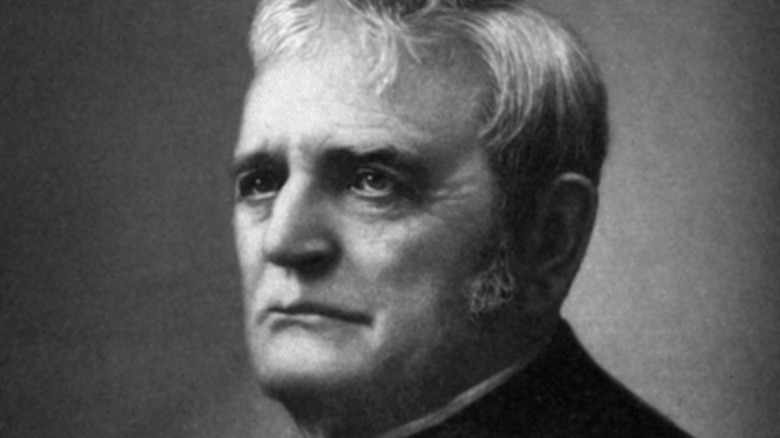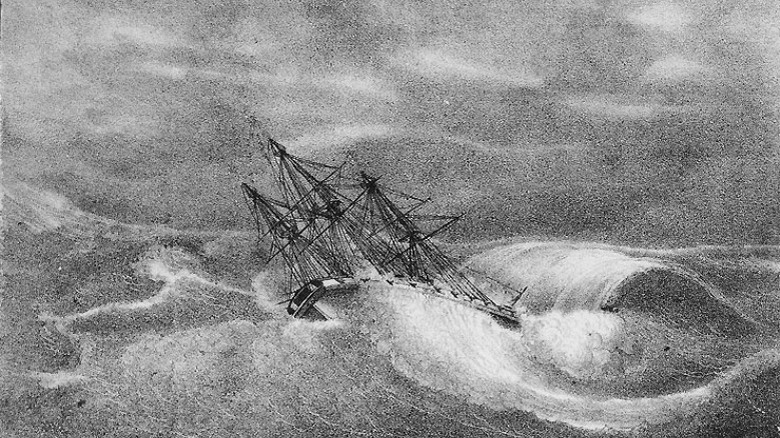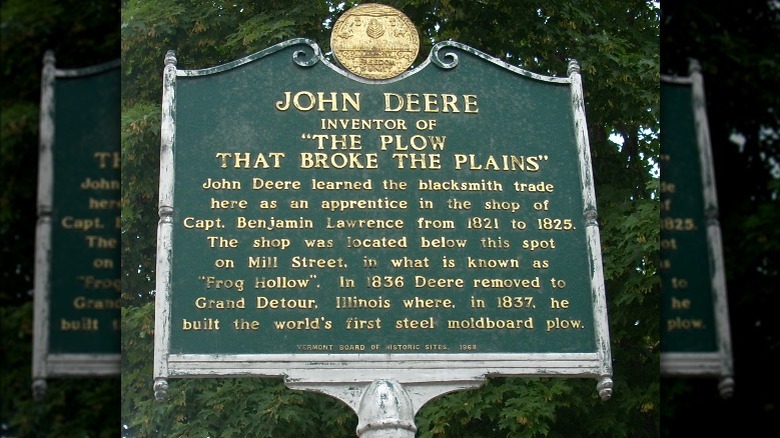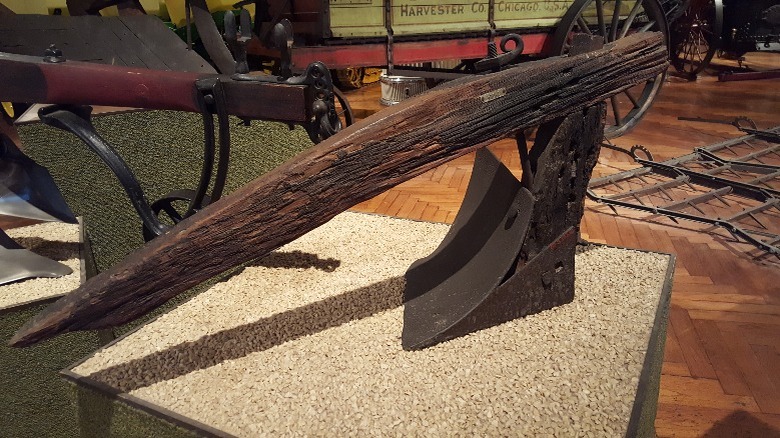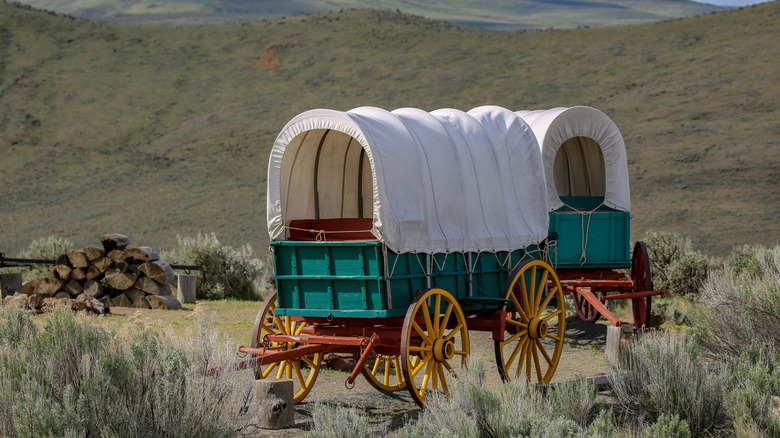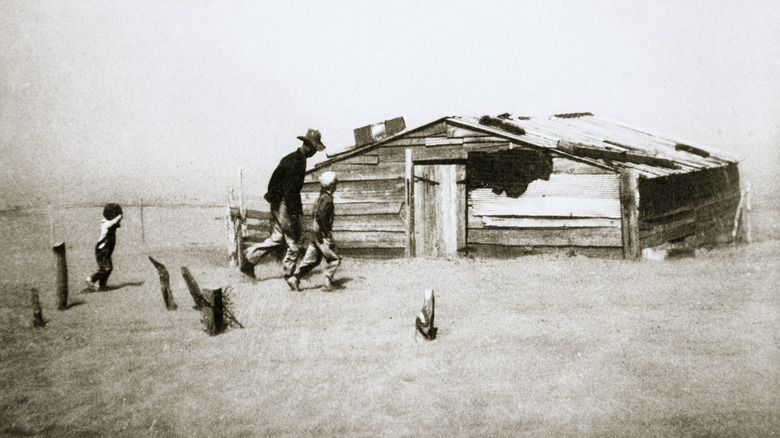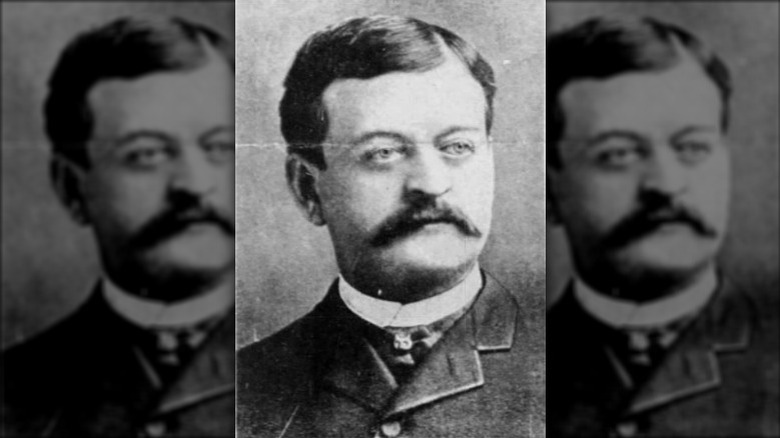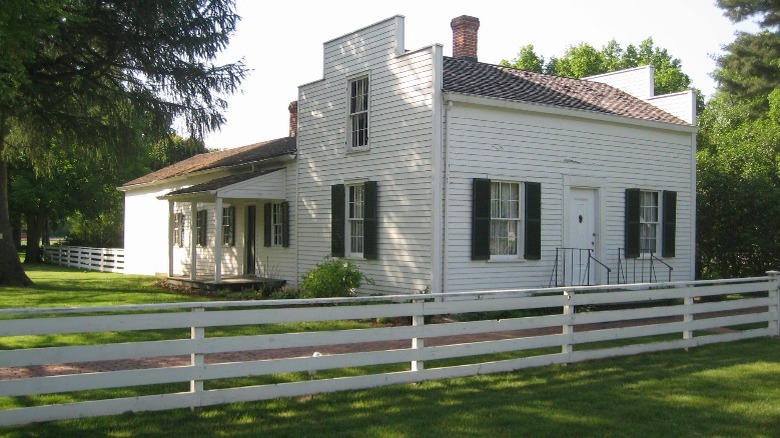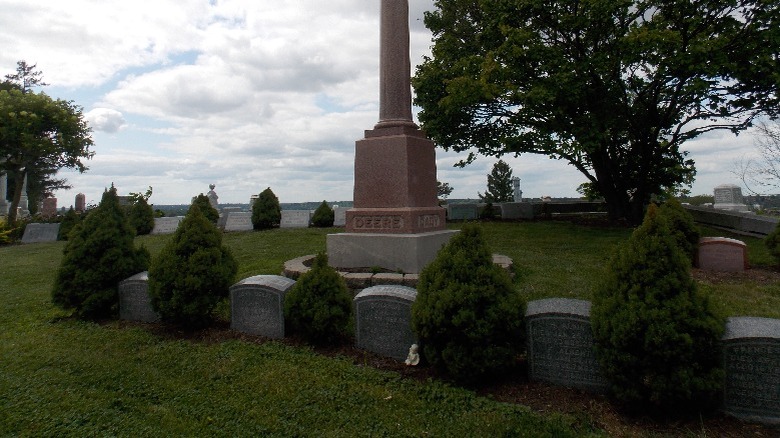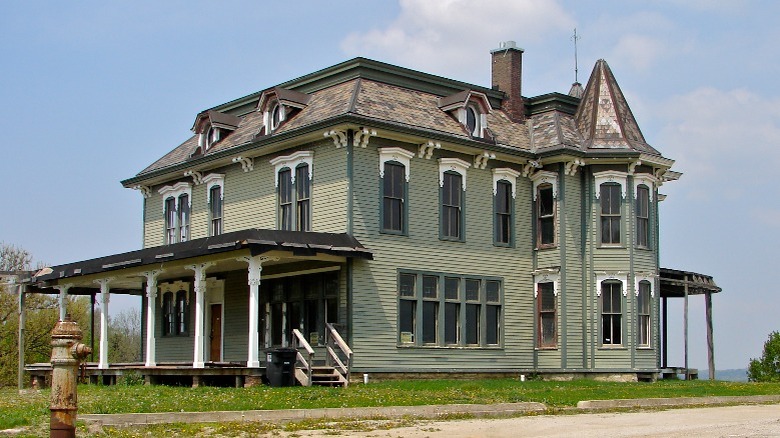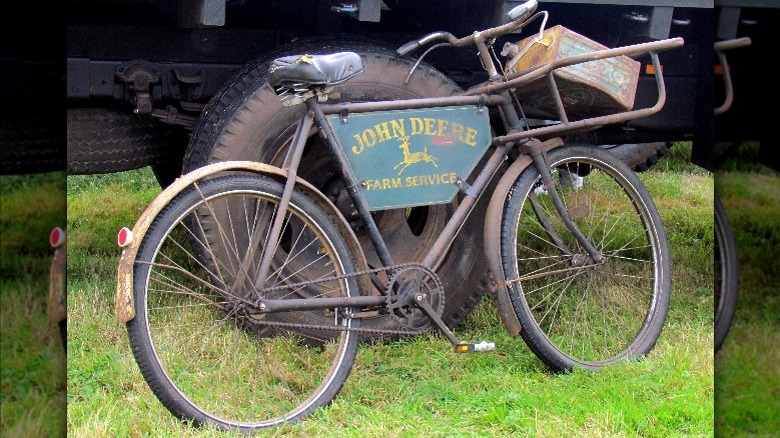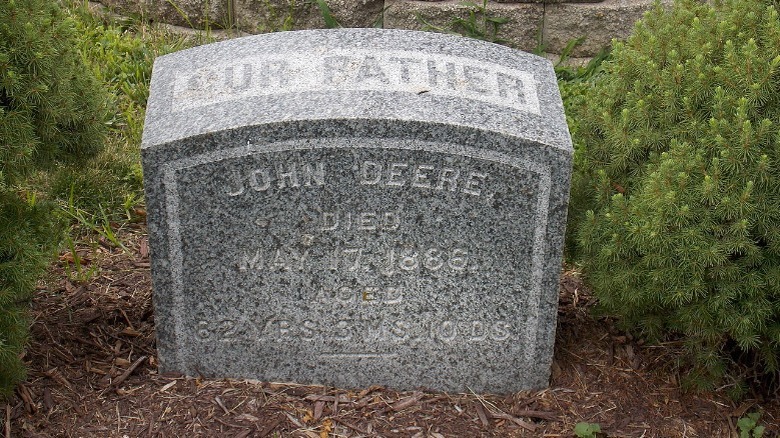Who Was The Real John Deere?
Even if you've never stepped foot on a farm in your life, you've heard the name John Deere. The company is synonymous with farming, as are its bright green and yellow tractors.
In fact, those colors are so iconic, they are officially called "John Deere Green" and "John Deere Yellow." You could walk into a paint store with the right codes and have the exact shade mixed up for you. In 1993, Joe Diffie even released a song called "John Deere Green," in which a teenage boy declares his love for a girl using a can of the paint, and they live happily ever after. (Wide Open Country says the tune made it to No. 5 on the Billboard Hot Country Singles chart.)
But even though some things about John Deere are so well known, a lot less information is out there about the guy who gave the company its name in the first place. So, just who was this John Deere guy? Let's find out.
John Deere's father disappeared when he was a child
While John Deere would go on to great success in life, he faced a major tragedy when he was very young. "John Deere: A History of the Tractor" records that young John's parents were English, and lived in America during the Revolutionary War. They settled in Vermont where they had six children, including John, who was born in 1804. Then his father William Deere, a tailor, was informed he should return to England to collect a small inheritance someone had left him, according to the New England Historical Society. The family never heard from William again.
While John Deere's official biography on the company's website says that his father was lost at sea, it's not clear if this is something their historians have hard evidence for or if it's just an assumption based on what was relatively common at the time. It's perfectly reasonable to conclude that someone embarking on a transatlantic voyage might not make it. When there were no letters from their loved one, the family would assume disaster must have struck. And sources don't even agree on when William left for England, with some saying 1808 and some 1812, when John would have been 4 and 8 years old, respectively.
The other option, if there is no solid proof William Deere was on a boat that sank, is that he simply abandoned his family. Famous Inventors notes this possibility along with that of William being lost at sea.
He started his career as a blacksmith
While John Deere's father had been a tailor, and his mother, Sarah, continued the business after William Deere vanished in the early 1800s, according to "John Deere: A History of the Tractor," John would instead start his career as an apprentice tanner – at the now very illegal age of just 8 years old. He didn't give up his education, though, at least not until he was 17. Then he started learning a new area of business, with an apprenticeship as a blacksmith.
Britannica records that John Deere served a 4-year apprenticeship before striking out on his own. Blacksmiths were invaluable to communities, and Deere quickly became known for small but important changes to designs for farm implements, which always made farmers' jobs much easier. In particular, he created a hay rake with smoothed tines. That might seem like a pointless change from unsmoothed tines, but it made such a difference in how quickly one could gather hay that they were incredibly popular.
John Deere also found time to get married and have children in the 12 years he spent as a blacksmith in Vermont. But according to the company's official website, the state's economy crashed in 1836, so Deere left his family behind while he went to find work elsewhere. In Illinois, he arrived in the town of Grand Detour, which had no blacksmith, and he was able to get his business started there in just two days. His family soon joined him.
John Deere perfected the steel plow
Back in those days, plowing a field was a long and arduous process. The equipment available didn't make it any easier for farmers, according to "John Deere: A History of the Tractor." Most of the farmers in Illinois would have been transplants from the East, like Deere was. They used plows that had been designed and built for much different soil than they encountered in the Midwest: Vermont soil had a sandy texture, while Illinois' was muddy and clumpy. This meant on top of pushing a plow through that dirt, the farmers had to constantly stop to clean the soil off the blade so they could continue on. It added a ton of time and backbreaking effort.
Deere made these inefficient plows when he first got to Illinois, but according to Smithsonian, the legend is that one day in 1838, Deere noticed a shiny broken saw blade in a sawmill and took it home. There, he crafted it into a plow and sold it to a neighbor. The shiny sides of the plow were so efficient at cutting through the soil that the neighbor raved about it to other neighbors.
Soon, everyone wanted one. In 1839, Deere sold 10 of his new plows, according to Britannica. In 1840, 40 flew off the shelves. In 1841, it was 75 orders; the next year he sold 100. By 1846, he was churning out 1,000 a year, and he was only getting started. By 1857, John Deere's company regularly sold 10 times that.
His plow probably made westward expansion possible
While John Deere is often credited as the inventor of the steel plow, plenty of other people realized plows needed improvements and were working on their own versions of steel plows, per Smithsonian. But Deere hit on the solution first and word of mouth spread so quickly that it was his design that changed everything: up to and including the size of the United States itself.
It's hard to fully grasp just how big a difference Deere's plow made to farmers. According to Encyclopedia.com, not only did farmers no longer have to stop and remove clumpy dirt from the blade every few feet, but these new plows could be pulled by horses instead of oxen, making the process even faster. Considering a large percentage of the population were farmers at the time, this meant thousands of people were suddenly able to farm quicker, farm larger areas, and turn previously unusable land into land that would produce food.
Encyclopedia.com puts this development in the same category as the expansion of railways and the Homestead Act when it comes to why Americans were able to keep colonizing further and further westward. John Deere's new plow completely and utterly changed agriculture, not just in the U.S. but around the world. Colonizers were able to move to areas that would have previously been worthless, unable to produce enough food to keep a large population alive. Deere could have had no idea when he shaped that first plow from a saw blade that he was effectively enabling Manifest Destiny.
John Deere's success led to an environmental disaster
While John Deere's invention and his success might have seemed like a win for everyone at the time, in reality, not only did it enable white Americans to push native tribes off their land, but it laid the seeds – so to speak – of an environmental disaster.
All that plowing completely changed the makeup of land that had been growing plants naturally until then. Not only were habitats for animals destroyed, but some fauna went extinct, and in some cases water sources became undrinkable. But, perhaps most dire for future generations, the ground wasn't taken care of in a way that would preserve the soil, as farmers at the time were only worried about production. "People put a lot of land into cultivation," Peter Liebhold, a curator at the National Museum of American History in Washington, D.C. told Smithsonian. "They just plowed up the prairie itself. ... It's all about getting rid of the native stuff that's there and turning the soil over. One of the downsides to that is that the soil gets washed away."
Decades of this type of farming would lead directly to the environmental disaster that was the Dust Bowl of the 1930s. With no native plants proliferating over the prairies, plants that had evolved to grow in a certain type of soil and to hold it down, the soil was blown away by the wind, turning into choking and destructive dust in the air.
He wasn't good at finances
John Deere might have been really good at making plows, coming up with other inventions and alterations, and getting his products out there, but no one is perfect. The one thing he was really bad at? Money.
John's finances were an issue in his business' early years for a couple of reasons. According to Green Magazine, he just wasn't good at the financial aspects of the business. After all, he'd been trained to be a blacksmith, but he left school at 17, so he never would have received any business training. That's fine if someone is running a small shop, but his company grew almost exponentially year-on-year. Even someone who knew what they were doing might be flummoxed by that kind of rapid expansion.
At first, John got financial help from various business partners. Then, in 1847, his eldest son Francis was finally old enough to join the firm and take care of the money side of things. Unfortunately, Francis died the next year. Apparently unwilling to have one of his daughters step in, John now had to wait for his second son, Charles (pictured), to grow up. The 11-year-old's destiny was set for him, so his parents made sure that he received a good education over the next five years, finally sending him to business college. At just 16, he joined his dad in the business. But Charles' involvement didn't solve everything, and when the Financial Panic of 1857 hit, John was forced to bring in new business partners again, albeit temporarily.
John Deere had nine kids
John Deere built a large company, but that didn't stop him from being home enough to build a heck of a large family as well. He has a whopping nine children with his first wife, Demarius Lamb.
Demarius had her hands full with that many kids to raise, sometimes literally. After John left Vermont and found a suitable home for his family in Illinois, Demarius and their first four children joined him. According to Green Magazine, she traveled by with the children, her brother-in-law, and the family's furniture for hundreds of miles in a wagon. When she arrived at the home in Grand Detour, Demarius handed her husband a new addition: his future business partner Charles, who was born while the couple was apart. Family legend has it that as she held out the baby to him, Demarius said, "Here, John. I carried him all the way from Vermont."
Of course, in a time with high infant mortality, not all of their children lived to adulthood. According to Find a Grave, of the couple's nine children, two died before they reached 2 years old. Francis, as previously mentioned, died unexpectedly at age 19 just after he joined his father's business. And a daughter, Frances, died three years later, aged just 16. However, others in the family were remarkably long-lived, like John and Demarius' eldest daughter Jeannette, who outlived all other members of her immediate family, and was in such robust health that even though she was 86 years old, her obituary said she died "suddenly."
His second wife was his first wife's younger sister
John and Demarius Deere were married almost 40 years. When she died in 1865, John must have been crushed, especially since had retired from the day-to-day running of his eponymous company the year before, according to Green Magazine, instead making his son Charles an equal partner and concerning himself only with the fun part of the business: inventing new things and improving old ones.
Some months after Demarius' death, per Green Collectors, Charles took time away from the business altogether, traveling back to Vermont to visit his late wife's family. However, he had another motive. It seems he might have been interested in proposing to the daughter of the man he'd done his blacksmith apprenticeship under way back in the 1820s — but it turned out that the woman was on her second husband at that point and unavailable.
At the Lamb home, however, John spent time with Demarius' sister Lucenia. The two had been only a few years apart in age and photos of the women show a pretty striking resemblance. And as Lucenia had never married, she was definitely available. John and his former sister-in-law were wed just over a year after Demarius' death. The new couple returned to Illinois and were together until John died two decades later. The Deeres lived a comfortable existence, and Lucenia enjoyed a quiet life despite her husband's fame. She died in 1888, two years after John passed away.
Per Find a Grave, John is buried with one wife on either side of him in the family plot (pictured).
John Deere was mayor of Moline, Illinois
When John Deere entered a period of semi-retirement in the 1860s, leaving the difficulties of running his eponymous company for his son to deal with, it meant he had the time and money to do what he liked. By this point, after moving a few times for business-related reasons, he was settled in the tiny town of Moline, Illinois. There, he'd built a big house (pictured) and prepared to live out his golden years.
But Moline was so small and such a new settlement that there was plenty of room for improvement. And just like he had with the steel plow decades before, Deere set out to make changes and adjustments to do just that. According to Illinois Farmer Today, Deere became the first mayor of Moline in 1873 (some sources say he was actually the second mayor). Perhaps it was no surprise he went into politics, considering the qualities that had made him a successful businessman. "He had pretty good listening skills," archivist and John Deere expert Neil Dahlstrom told the publication. "I was surprised how well-rounded he was."
As mayor, Deere spearheaded the installation of gas lighting in public areas, as well as (per a previous version of his biography on the John Deere official website) repairing infrastructure, including streets, sidewalks, and sewers. He also passed a very unpopular temperance law. Deere served as mayor for two years, before deciding to leave politics for good. He spent most of his later years traveling, before his death on May 17, 1886, aged 82.
His company got caught up in the bicycle craze
While the John Deere brand is synonymous with farm equipment and heavy machinery, it did branch out to other areas of manufacture over the years. Perhaps the most notable was when the company was one of many to get caught up in the bicycle mania of the late 1800s.
By this point, John Deere the person was already dead, so he had nothing to do with the decision, but his family was still in control of the company. It was a grandson of Deere, C.C. Webber, who pushed especially hard for the company to get in on the lucrative bicycle market. According to Farm Collector, in an 1893 memo, Webber wrote, "If there is anything in this bicycle business, any money to be made, we want to take hold of it." This shows just how bike-mad the country had gone at that time, considering only a few years before, Webber was writing memos complaining about the company entering other areas: "Your [salesman's] first duty is to get the plow trade. In the hustle for wagon [and] buggy trade, none of us want to overlook the fact that the plow trade is our principal mission."
The company produced three of their own models of bike, and even sponsored a 20-mile bicycle race in 1895, according to "John Deere: A History of the Tractor." During the height of the fad, the gamble paid off, with $150,000 in bike sales (around $4 million in today's money).
John Deere is remembered as a fair businessman
Perhaps the most famous quote attributed to John Deere is, "I will never put my name on a product that does not have in it the best that is in me" (via "The John Deere Way: Performance that Endures"). This was a huge part of why he became so successful. It wasn't about making tools that would wear out or become obsolete so people would have to buy more. This led to a great deal of trust in his products, which originally became popular through word of mouth alone. "His name meant something," Neil Dahlstrom, co-author of "The John Deere Story: A Biography of Plowmakers John and Charles Deere," told Illinois Farmer Today.
It was this sense of honor that he passed down to his son, Charles, who took over the company in the 1860s. By that point, his father had impressed on him the most important aspects of business, which is clear from the oath Charles wrote down promising, "I will never from this Seventh day of February Eighteen Hundred Sixty AD put my name to a paper that I do not expect to pay — so help me God" (via Green Magazine).
John Deere, the man, is still remembered for these qualities today. Former Deere & Company chairman Robert Hanson said (via Encyclopedia.com), "He stressed quality and value in his products and services. He stayed close to the customers in order to provide them with products they needed to meet their individual requirements. Above all, he emphasized fair dealings and the principle of mutual advantage for all who came in contact with his company."
